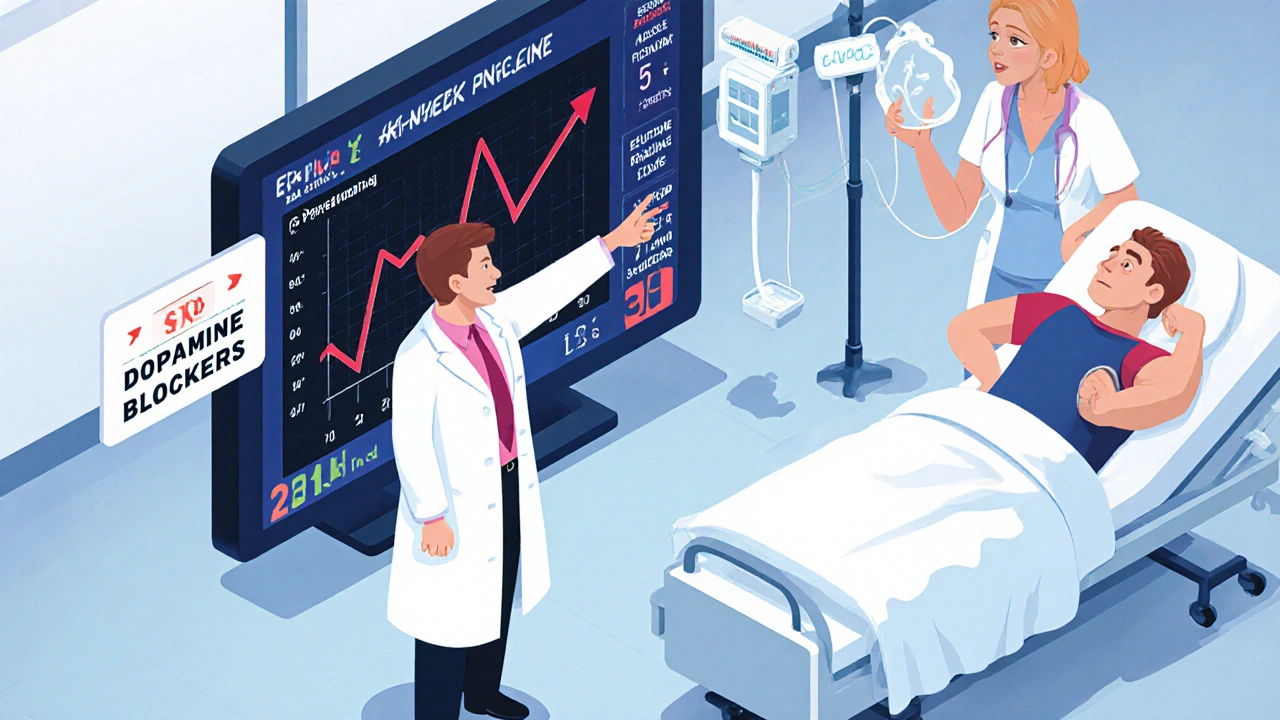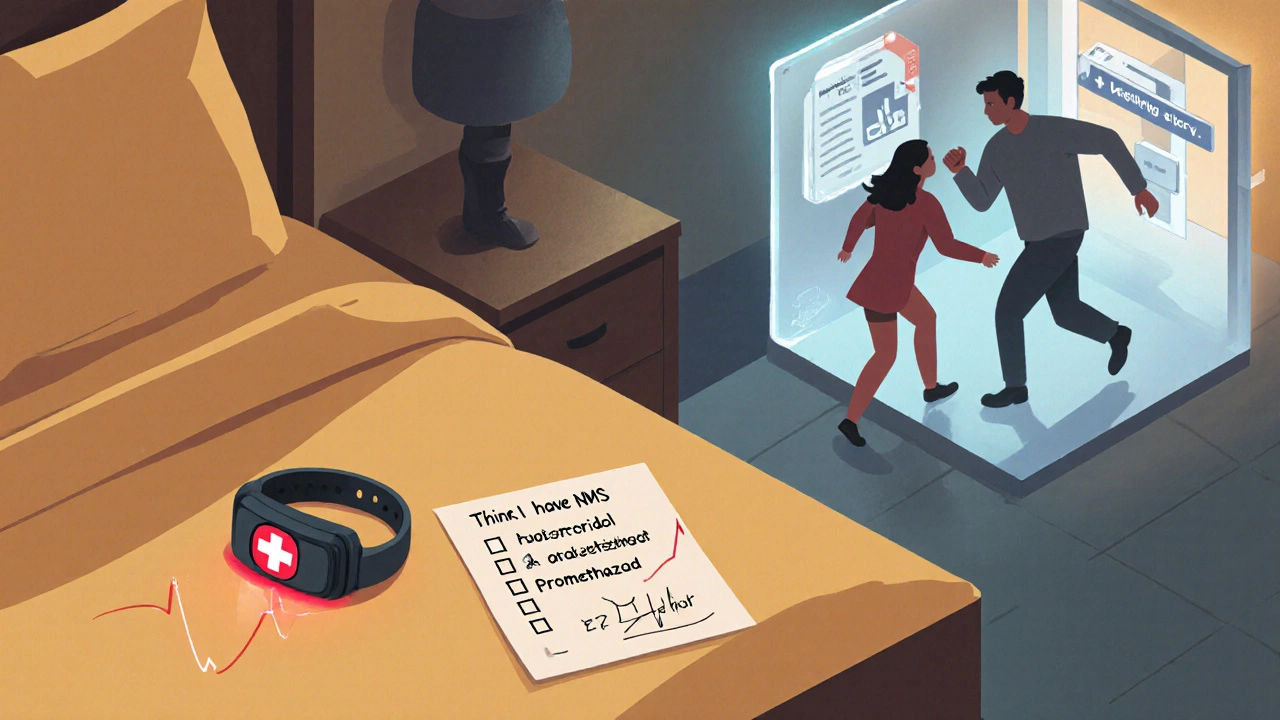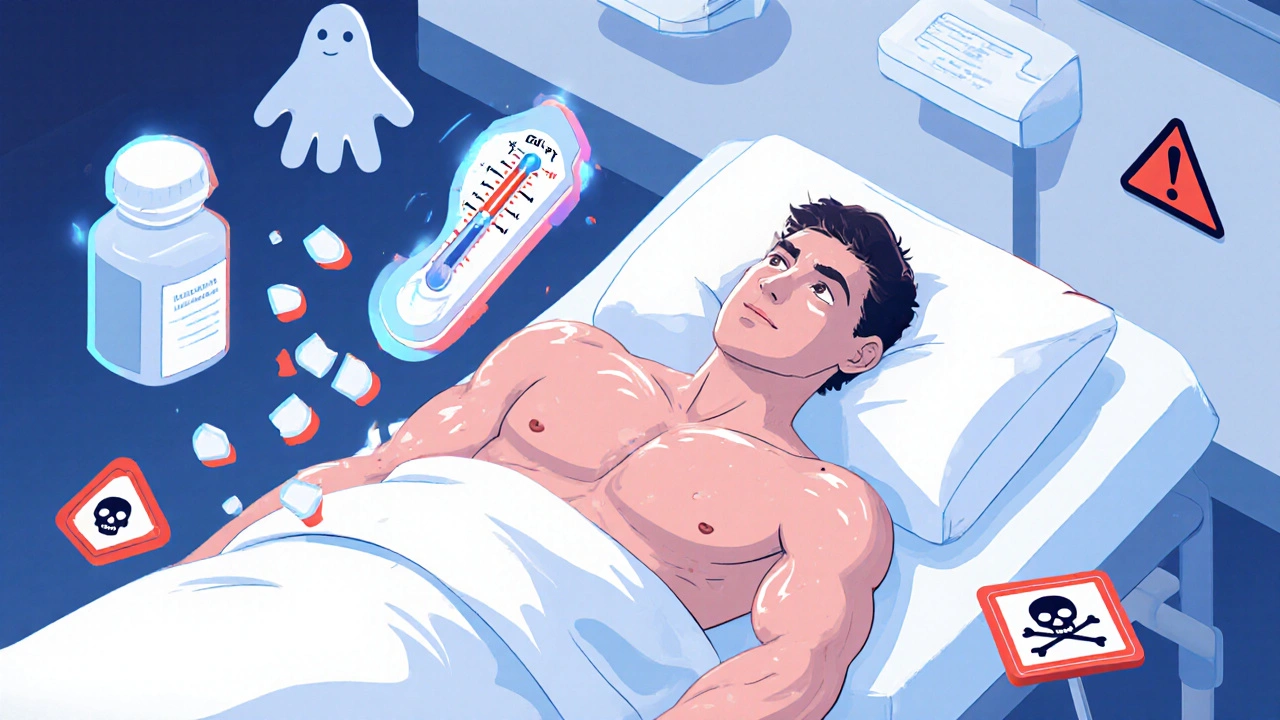NMS Symptom Checker & Risk Assessment Tool
Is This NMS?
Neuroleptic Malignant Syndrome is a rare but life-threatening reaction to certain medications. This tool helps you assess potential symptoms. If you or someone you know is experiencing these symptoms, seek emergency medical care immediately and tell the doctors "I think I might have neuroleptic malignant syndrome".
Imagine waking up in the hospital after being told your body went into overdrive - muscles locked like concrete, temperature spiking past 105°F, and you couldn’t speak or move. This isn’t a scene from a movie. It’s neuroleptic malignant syndrome (NMS), a rare but deadly reaction to certain psychiatric medications. Most people never hear about it until it’s too late. And that’s the problem.
What Exactly Is Neuroleptic Malignant Syndrome?
Neuroleptic malignant syndrome is a severe, life-threatening reaction to drugs that block dopamine in the brain. These include antipsychotics like haloperidol, risperidone, and olanzapine, but also anti-nausea meds like metoclopramide and promethazine. It’s not an allergy. It’s not psychosis getting worse. It’s your body’s nervous system going haywire because dopamine - a key chemical for movement, temperature control, and mental clarity - gets shut down.
The condition shows up as four clear signs, often in this order: first, confusion or agitation; then, muscles stiffening like a statue (called "lead pipe rigidity"); next, fever above 100.4°F; and finally, wild swings in heart rate, blood pressure, and sweating. These symptoms don’t appear overnight. Most cases start within two weeks of starting or increasing a medication, but they can hit as fast as 48 hours - or even months later.
What makes NMS dangerous isn’t just the symptoms. It’s what follows. Muscle breakdown (rhabdomyolysis) floods the blood with a protein called myoglobin, which can crash your kidneys. High potassium levels can trigger cardiac arrest. Liver enzymes spike. White blood cells go through the roof. Without quick action, 10 to 20 percent of cases are fatal. Even with treatment, 5 percent still die.
How Is NMS Different From Other Conditions?
Doctors often miss NMS because it looks like something else. The most common mix-ups are serotonin syndrome and malignant hyperthermia.
Serotonin syndrome happens faster - usually within hours of a new drug or dose change. It’s marked by twitching, clonus (involuntary muscle jerks), and diarrhea. NMS? Slower onset, no clonus, and far more rigidity. You’ll see mutism, not hyperactivity. Your muscles won’t twitch - they’ll feel like they’re fused.
Malignant hyperthermia is even more urgent. It strikes during anesthesia, not from psychiatric meds. You get jaw clenching, rapid breathing, and a body temperature that climbs within minutes. NMS creeps up. But both can be treated with dantrolene, a muscle relaxant that helps stop the runaway heat and stiffness.
Here’s the kicker: up to 12 percent of NMS cases are misdiagnosed as a psychotic episode or infection. That delay can cost lives. One patient on a mental health forum described being told, "It’s just your schizophrenia acting up," while his body temperature hit 105.1°F. He spent nine days in ICU.
Who’s at Risk?
NMS is rare - affecting only 0.01 to 3.2 percent of people taking antipsychotics. But some groups are far more vulnerable.
First-generation antipsychotics like haloperidol carry the highest risk - up to 2 percent of users. Second-generation drugs like quetiapine or clozapine are much safer, with rates as low as 0.01 percent. That’s why doctors now avoid high-dose haloperidol unless absolutely necessary.
Other red flags:
- Rapid dose increases - jumping haloperidol by more than 5 mg per day
- Injectable forms of antipsychotics
- Combining antipsychotics with lithium
- Dehydration or high environmental heat
- Being male and under 40
- Having bipolar disorder (higher risk than schizophrenia)
And here’s something few know: NMS can also happen when Parkinson’s meds like levodopa are suddenly stopped. About 5 percent of cases come from withdrawal, not starting a new drug.

How Is NMS Diagnosed?
There’s no single blood test for NMS. Diagnosis is clinical - meaning it’s based on symptoms and ruling out other causes.
Doctors look for:
- Temperature over 38°C (100.4°F) confirmed twice
- Severe, uniform muscle rigidity
- Changes in mental status - from restlessness to coma
- Autonomic signs: heart rate over 90 bpm, blood pressure swings, sweating
Lab tests help confirm it:
- CK levels above 1,000 IU/L (often over 10,000 - normal is under 200)
- High white blood cell count (over 12,000/µL)
- Low serum iron (below 60 µg/dL)
- Acidic blood (low bicarbonate)
- Elevated liver enzymes or potassium
CK is the most telling marker. It rises as muscles break down. Levels peak around 72 to 96 hours after symptoms start. If CK is sky-high and you’re on an antipsychotic? NMS is likely.
What Happens If It’s Not Treated?
Left untreated, NMS doesn’t just hurt - it destroys.
Severe muscle breakdown leads to myoglobinuria - a gunk that clogs kidney tubules. About 30 percent of serious cases develop acute kidney injury. Some need dialysis. Others suffer permanent damage.
Heart rhythm problems from high potassium can cause sudden death. Liver failure, seizures, and respiratory arrest are also risks. The longer you wait, the worse the outcome.
One study found that if treatment is delayed more than 24 hours, complications jump by 40 percent. And survivors? Around 15 percent still have muscle weakness at 30 days. Recovery isn’t quick. One man on a support forum said it took eight weeks to walk without help after his muscles finally relaxed.

How Is NMS Treated?
Time is everything. The moment NMS is suspected, you stop the drug - immediately. No exceptions. No waiting for lab results.
Standard treatment steps:
- Stop all dopamine blockers. That includes antipsychotics, anti-nausea meds, even certain Parkinson’s drugs if they’re still in the system.
- Cool the body. If temperature is above 38.9°C (102°F), use cooling blankets, ice packs, and IV fluids. Don’t wait - fever can spike dangerously fast.
- Hydrate aggressively. Give 1 to 2 liters of IV fluids right away, then maintain 100-150 mL/hour. This protects the kidneys from muscle breakdown toxins.
- Use dantrolene. This muscle relaxant helps stop the rigidity and heat. Start at 1-2.5 mg/kg IV, and repeat as needed up to 10 mg/kg. It’s not a cure, but it saves lives.
- Consider bromocriptine or apomorphine. Bromocriptine (an oral dopamine agonist) helps restore dopamine activity. Apomorphine, given as a nasal spray, is being tested in trials and can drop fever in under 4 hours.
Patients need ICU care. Continuous heart, kidney, and temperature monitoring is mandatory. Blood tests for CK, electrolytes, and kidney function are checked every 6 to 12 hours until levels start falling.
Recovery usually takes 7 to 10 days - if caught early. Some take weeks. Muscle strength returns slowly. Mental clarity often comes back faster than movement.
What Happens After Recovery?
Survivors face a hard choice: go back on antipsychotics or risk relapse.
A 2022 survey found 65 percent of NMS survivors were too scared to restart any dopamine-blocking medication - even if they were still struggling with psychosis or mania. That’s a huge problem. Untreated mental illness carries its own risks.
Doctors now have options. If a patient needs antipsychotics again, they start with the lowest possible dose of a low-risk drug - like quetiapine or clozapine - and move slowly. Some use non-dopamine alternatives like benzodiazepines or mood stabilizers as bridges.
There’s also new hope. Researchers are testing AI tools that scan hospital records for early NMS signs - like sudden fever + rising CK - and alert staff 24 hours before symptoms become obvious. Early trials show 85 percent accuracy.
The FDA now requires all antipsychotic labels to carry a black box warning about NMS. That means every prescription comes with a clear alert: "This drug can cause a rare, fatal reaction. Watch for stiffness, fever, and confusion. Act fast."
What Should You Do If You Suspect NMS?
If you’re on an antipsychotic or anti-nausea drug and notice:
- Muscles suddenly stiffening
- Fever that won’t break
- Confusion, agitation, or inability to speak
- Rapid heartbeat or sweating without cause
Don’t wait. Don’t call your therapist. Don’t wait until tomorrow. Go to the ER - and tell them: "I think I might have neuroleptic malignant syndrome. I’m on [medication name]." Say it out loud. Most ER doctors don’t think of it. You have to name it.
Keep a list of all your meds - including over-the-counter ones - and bring it with you. Many cases are triggered by drugs you didn’t even think were risky, like promethazine for nausea.
If you’ve had NMS before, wear a medical alert bracelet. And never restart a dopamine blocker without a clear plan with your psychiatrist and a neurologist.
It’s rare. But it’s real. And if you know the signs, you might just save a life - even your own.
Can NMS happen with second-generation antipsychotics?
Yes, but it’s extremely rare. Second-generation antipsychotics like olanzapine, quetiapine, and clozapine have a much lower risk - about 0.01 to 0.02 percent - compared to older drugs like haloperidol (0.5-2 percent). Still, cases have been reported, especially with rapid dose increases or in patients with other risk factors like dehydration or kidney issues.
Is NMS the same as a psychotic episode?
No. A psychotic episode involves hallucinations, delusions, or disorganized thinking - but the body stays physically normal. NMS affects the whole body: muscles lock, temperature spikes, heart races. Someone with NMS may be mute or confused, but they’re not having delusions - they’re physiologically collapsing. Mistaking NMS for psychosis delays treatment and can be deadly.
Can you get NMS from stopping antipsychotics too quickly?
Yes - but only if you’re stopping a dopamine-boosting drug like levodopa (used for Parkinson’s). Abruptly stopping these can trigger NMS-like symptoms within 24-72 hours. Stopping antipsychotics themselves doesn’t cause NMS, but it can lead to withdrawal dyskinesia or rebound psychosis - which are different.
How long does it take to recover from NMS?
Most people recover in 7 to 10 days with prompt treatment. But muscle weakness can linger for weeks or months. One study found 15 percent of survivors still had trouble walking or lifting things after 30 days. Full recovery depends on how quickly treatment started and how severe the muscle damage was.
Are there any long-term effects after surviving NMS?
Some survivors have lasting muscle weakness or kidney damage. Others develop anxiety about taking any psychiatric meds again. A small number report chronic pain or movement issues. But with proper rehab and follow-up, most regain normal function. The biggest long-term challenge is often psychological - fear of relapse makes people avoid necessary treatment.
Can NMS be prevented?
Yes, in most cases. Avoid high doses of first-generation antipsychotics. Don’t increase doses rapidly. Avoid combining antipsychotics with lithium or dehydration. Use second-generation drugs when possible. Monitor for early signs: stiffness, fever, confusion. If caught within 24 hours, outcomes improve dramatically. Awareness is the best prevention.
